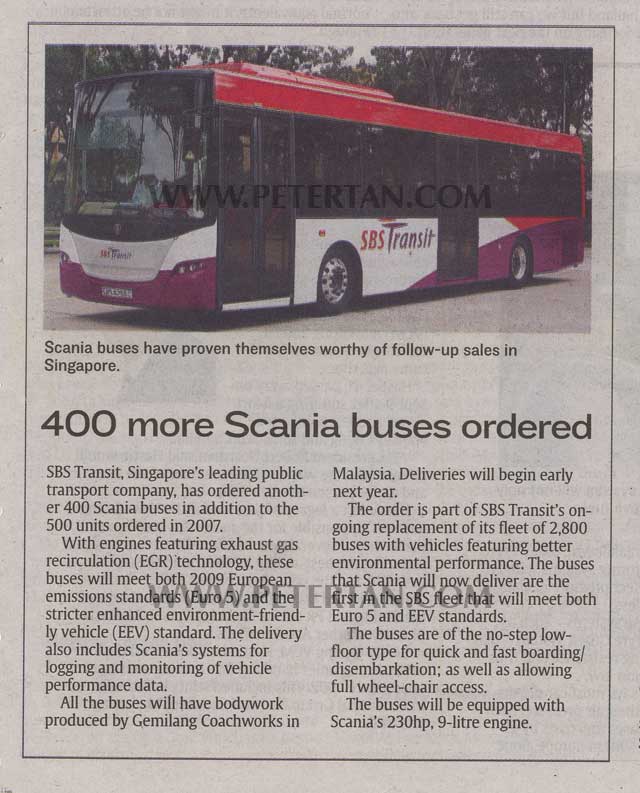There are two things that disable people. One is attitude, the other is the environment. Of the two, attitude is the most difficult to change yet is the easiest to do. All that is needed is to understand the Social Model of Disability. Nevertheless, people still have the perception that people are disabled by their conditions and therefore are to be blamed if they cannot use public amenities. Furthermore, facilities suited for use by disabled people are often delegated to the lowest of priorities because disabled people are not considered productive citizens worthy of the money spent.
Is it that difficult to see that what is good for disabled people is good for everyone else? Countries like Japan and Australia have already adopted inclusive policies that require that public amenities are accessible to everyone. It was in Tokyo that I experienced real liberation as a wheelchair user for the first time. If that can be done in Japan why then can it not be done here in the spirit of Malaysia Boleh?
Apparently people who are in position to change things are not interested to make Malaysia an inclusive society. They prefer to cling on to their prejudices and cocoon themselves in their own comfort zone. They refuse to lift a finger to improve the situation but prefer to turn a blind eye to the fact that disabled people are in Malaysia are so marginalized that many are living in conditions of abject poverty.
Now I begin to understand why the advocacy for accessible public transport in Malaysia has not moved forward as fast as I had expected. It was naive on my part to think that the situation can be easily resolved by writing a few letters to the authorities concerned and meet with ministers to lay out the problems to them.
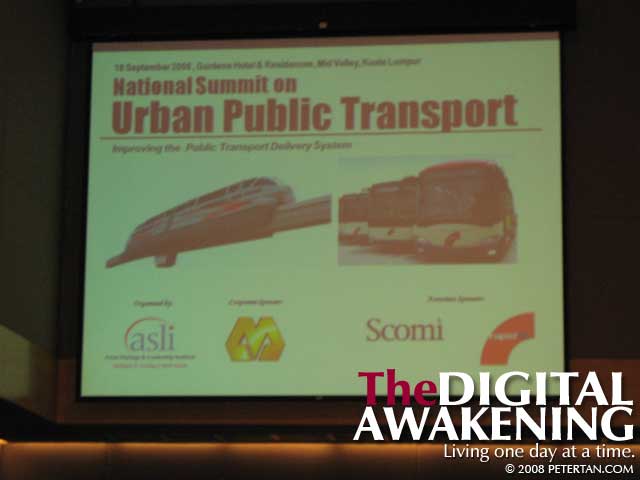
I discovered this sad fact at the National Summit on Urban Public Transport organised by Asian Strategy and Leadership Institute (ASLI) at The Gardens Hotel and Residences last Thursday. Datuk Ong Tee Keat officiated the summit. In his keynote address he said the following among others:
It is also essential to highlight, that a public transport is not an exclusive domain of sections of the population, but must cater for all. The disabled community is an integral part of our communities and I do urge that their needs must be integrated in our public transport planning.
Although I have an inherent mistrust of politicians delivering well crafted speech and not fulfilling it afterwards, I am going to give Datuk Ong the benefit of the doubt and welcome this statement. I believe that he is serious in resolving the transportation woes of disabled people. The only ironic thing about this entire matter is that the Minister of Transport does not have full control over the regulation of public transport in Malaysia. It is being jointly regulated by thirteen agencies with some having overlapping jurisdiction over another.
My main purpose in attending the summit was to see what is being done to make public transport accessible. When Syarikat Prasarana Negara Berhad (Prasarana) Chief Executive Officer Shaipudin Shah Harun spoke during the panel session titled “Towards an Efficient Urban Public Transport System,” I was all ears.
Prasarana is the asset owner of RapidKL. It owns all the RapidKL and Rapid Penang buses, Kelana Jaya Line and Ampang Line light rail transit networks, KL Monorail and the Langkawi Cable Car System. Prasarana in turn is a wholly-owned government company under the Ministry of Finance Inc.
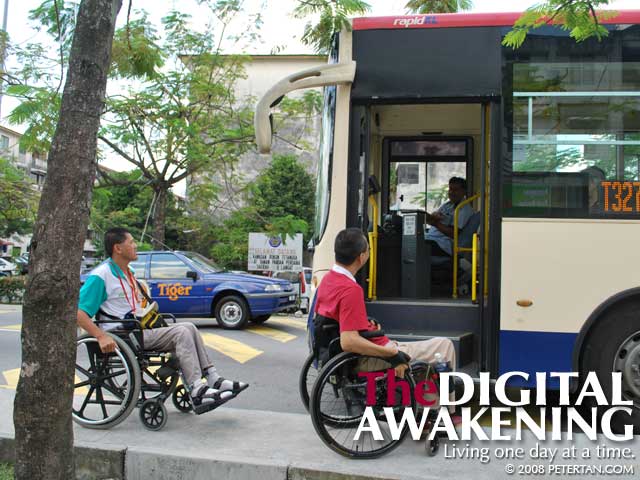
Photo by Wuan.
At the Q&A session afterwards, I asked the following:
When we talk about public transport, why are disabled people left out of the equation? Is Prasarana going to buy non-step buses from now on or continue to put buses with steps on the road?
Below are Shaipudin’s response transcribed from the video recorded by fellow participant Naziaty Yaacob:
The issues of building structures. What good would it do for you to be able to get up a bus which is low floor and then you have pavements which are uneven with manholes uncovered.
The country as a whole must have what you call a real policy on the issue of the OKU.
We try our best. As for the same question, for all the new facilities that we are putting up, the trains and all that, for the new lines, the extension lines, all the needs of the OKUs are being registered and will be taken for but as I said there will not be the end to the answer to your problem.
What happens when you leave our stations? Are the streets friendly enough for you?
This is not a Prasarana question question alone.
The problem here is not only faced by OKU. Even the able people too are having problems. How many walkways do you see along the streets which enable us to walk conveniently?
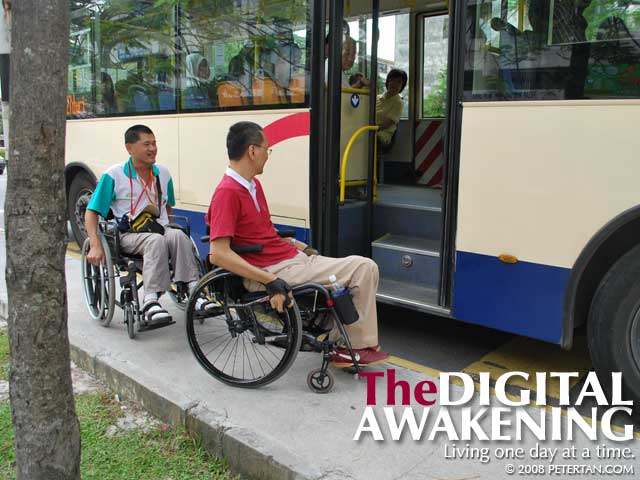
Photo by Wuan.
My question to Prasarana was actually very straightforward. A simple “yes” or “no” would have sufficed. Instead, Shaipudin gave a discourse on the inaccessible built environment. I do not disagree with his view that disabled people may face problems after getting off the buses. Nevertheless, Prasarana should just concentrate in ensuring that all its buses, trains and terminals are fully accessible. The municipals councils are the parties responsible for the built environment other than those owned by Prasarana and that matter should be left to these municipalities to resolve. If Prasarana is going to wait until the built environment is fully accessible before they change the entire fleet to non-step buses, disabled people may have to wait another ten years or even longer to be able to use public transport.
Shaipudin also argued that non-disabled people are also facing problems with the built environment. It is true that non-disabled people encounter such problems too but that does not usually prevent them from getting to the bus stop to catch a bus. Additionally, it does not take long to add ramps to existing walkways. The 500 meter stretch in Pandan Perdana including the bus stop, although not built to specifications, was made accessible in a period of less than one month.
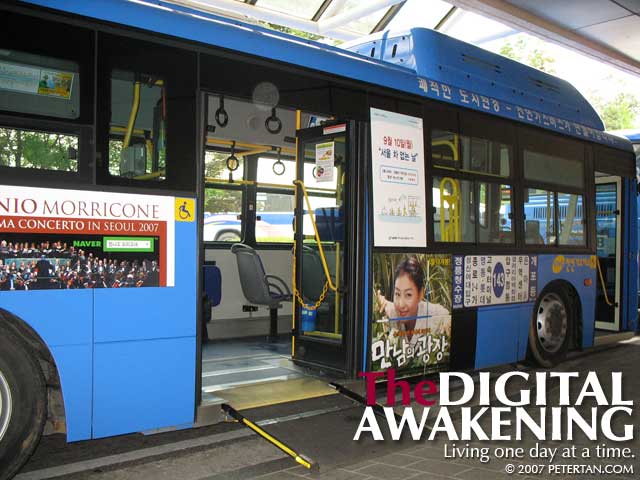
Non-step bus with the ramp deployed in Seoul, Korea.
Truth be told, I am ignorant of the lifepspan of RapidKL’s buses. Lets guesstimate that these buses are phased out after ten years of service. If the municipal councils are able to make most of the bus stops accessible within two years from now, that means disabled people have to wait at least five more years for the current buses to be replaced with non-step ones. And if Prasarana continues to put new buses with steps into service, how long more before disabled people can ride in public buses?
Prasarana as the asset owners with its hardware paid for from the people’s money via the Ministry of Finance Inc. must ensure that all buses purchased in the future must be accessible to everyone. Non-step buses are most suitable for this purpose. Such buses are widely available and used in major cities in the Asia Pacific countries like Japan, Korea and Australia. These buses are not only convenient for wheelchair users but for senior citizens and people with mobility impairments, pregnant women and children. What is good for disabled people is good for everyone else.
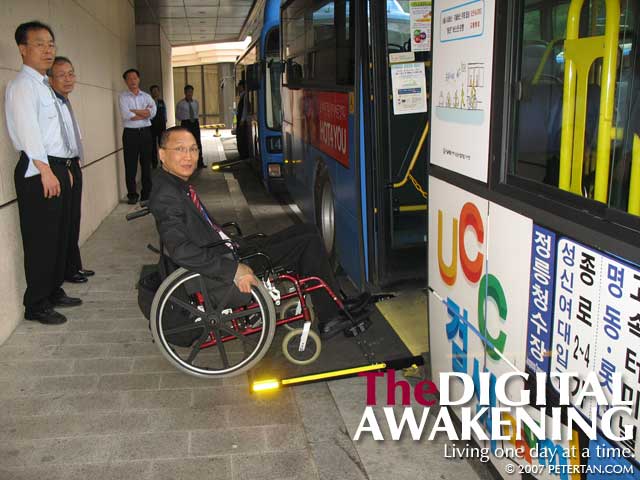
Boarding the non-step bus in my wheelchair in Seoul, Korea.
What I cannot understand is Prasarana’s reluctance in making all their new buses accessible. Is Prasarana going to lose anything by including the transportation needs of disabled people? Everybody benefits if these buses are accessible. The Minister of Transport has already acknowledged that disabled people are an integral of the community. Why then is Prasarana continuing with its disabling policy that marginalizes disabled people?
Without access to public transport, disabled people are unable to achieve a reasonable quality of life. We are unable to go to schools and go to work. We are unable to participate in social, cultural, religious and political activities. Prasarana’s is attitude in this issue is most baffling. It has failed in the task entrusted to it by the government to provide the assets to RapidKL and Rapid Penang to run a public transport service to benefit everyone.

